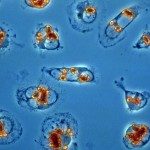Lien vers Pubmed [PMID] – 16319894
Nature 2005 Dec; 438(7068): 679-84
Protein phosphorylation is estimated to affect 30% of the proteome and is a major regulatory mechanism that controls many basic cellular processes. Until recently, our biochemical understanding of protein phosphorylation on a global scale has been extremely limited; only one half of the yeast kinases have known in vivo substrates and the phosphorylating kinase is known for less than 160 phosphoproteins. Here we describe, with the use of proteome chip technology, the in vitro substrates recognized by most yeast protein kinases: we identified over 4,000 phosphorylation events involving 1,325 different proteins. These substrates represent a broad spectrum of different biochemical functions and cellular roles. Distinct sets of substrates were recognized by each protein kinase, including closely related kinases of the protein kinase A family and four cyclin-dependent kinases that vary only in their cyclin subunits. Although many substrates reside in the same cellular compartment or belong to the same functional category as their phosphorylating kinase, many others do not, indicating possible new roles for several kinases. Furthermore, integration of the phosphorylation results with protein-protein interaction and transcription factor binding data revealed novel regulatory modules. Our phosphorylation results have been assembled into a first-generation phosphorylation map for yeast. Because many yeast proteins and pathways are conserved, these results will provide insights into the mechanisms and roles of protein phosphorylation in many eukaryotes.


